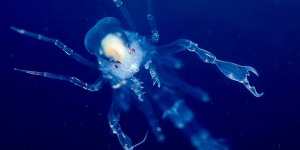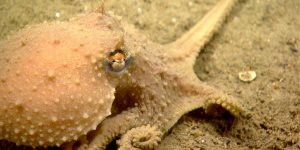Science News

The sea is Earth's most formidable carbon dioxide storage machine, but mysteries abound about the interlocking processes and the myriad organisms involved. »

Rocks tell story of asteroid that doomed the dinosaurs. »

In a footage, an Octopus named Heidi changes skin-color, from light to dark, while sleeping upside-down in a tank making scientists believe that they can dream. »

Bird populations can recover from hurricane impacts in two decades. »

Expansion dominates the rock weathering process. »

Study shows that haddock larvae orient toward the northwest. »

Once dismissed as ‘junk DNA’ that served no purpose, a family of ‘jumping genes’ found in tomatoes has the potential to accelerate crop breeding for traits such as improved drought resistance. »

Scientists have found the live microorganisms that boost 'good bacteria' in the stomach can enhance weight loss. »

A wireless sensor small enough to be implanted in the blood vessels of the human brain could help clinicians evaluate the healing of aneurysms -- bulges that can cause death or serious injury if they burst. »

While history has played an important role in the distribution and diversity of fish species in the Amazon basin, climate change, deforestation and building of power dams could alter such dynamics even more. »

Researchers have developed soft robotic devices driven by neuromuscular tissue that triggers when stimulated by light -- bringing scientists one step closer to autonomous biobots. »

Researchers use artificial intelligence to better understand bird migration data. »

Scientists used ancient DNA analyses and carbon-14 dating to demonstrate the past existence of a unique population of Icelandic walrus that went extinct shortly after Norse settlement some 1,100 years ago. »
Researchers identified an almost complete set of proteins, a proteome, in the dental enamel of the rhino and the genetic information discovered is one million years older than the oldest DNA sequenced from a 700,000-year-old horse. »

A day is the time for Earth to make one complete rotation on its axis, and a year is one revolution around the Sun -- reminders that basic units of time and periods on Earth are intimately linked to our planet's motion in space. »

People have very individualized inflammatory responses to eating a high-fat meal. »

Scientists have designed an ultra-miniaturised device that could image single cells without the need for a microscope or make chemical fingerprint analysis possible from within a smartphone camera. »

The nutrient phosphate may be less abundant in the global ocean than previously thought. The researchers compiled data collected using sensitive techniques that measure phosphate to create a more accurate dataset to power global ocean models. »

Treating preterm infants with antibiotics for more than 20 months appears to promote the development of multidrug-resistant gut bacteria. »

Using radar data from NASA's Cassini spacecraft, recently published research presents a new scenario to explain why some methane-filled lakes on Saturn's moon Titan are surrounded by steep rims that reach hundreds of feet high. »

A report by a team from the University of Hawaii at Mānoa and the University of Southern California, say the eruption of the Kīlauea volcano last year has been followed by a dramatic increase in the population of phytoplankton, also called green algae, in the waters surrounding the island. »

University of Arizona scientists trekked across the Americas: from moist, tropical jungles of Panama to the frigid boreal forests of Colorado to the wet temperate forests of the Pacific Northwest. »

Researchers discovered two plant genes that may reduce the effects of over-fertilization. »

Researchers have identified a gene associated with migration in golden-winged warblers. »

Recent developments in genetic modification (GM) technology include a way to prevent the popular Cavendish banana variety from being wiped out by the Fusarium wilt fungus. »

In 2016, researchers working in the Afar region of Ethiopia, some 35 miles away from Hadar, the region in which "Lucy," the famous Australopithecus afarensis human ancestor, was found, discovered a nearly complete cranium of another early human ancestor, Australopithecus anamensis, that dates to 3.8 million years ago. »

Researchers at the University of Cambridge, who led a new study, say the findings reinforce the importance of an active lifestyle when planning pregnancy. »

The mosquito-repellent properties of thyme oil have long been known. But now a team of researchers have harnessed the power of this humble herb to attack the insect’s larvae before it can spread, using another common ingredient. »

Team is first to create a solar-driven water-splitting catalyst to produce renewable energy. »

Researchers have discovered that blood vessels within bone marrow may progressively turn into bones with advancing age and run around the bloodstream. »

Scientists discover species turnover in more than 100 grassland experiments. »

Graphene could provide alternative to chemicals in insect repellant and protective clothing. »

Researchers from North Carolina State and Elon Universities have developed a technique that allows them to remotely control the movement of soft robots, lock them into position for as long as needed and later reconfigure the robots into new shapes. »

Scientists have recovered the first genetic data from an extinct bird in the Caribbean, thanks to the remarkably preserved bones of a Creighton's caracara in a flooded sinkhole on Great Abaco Island in the Bahamas. »

Researchers have developed artificial ‘chameleon skin’ that changes colour when exposed to light and could be used in applications such as active camouflage and large-scale dynamic displays. »

Algae key to the ocean carbon cycle are scarce in equatorial waters. »

Scientists use machine learning to recognize potentially damaging storms. »

Plants have circadian rhythms that help them tell the time of day, preparing plants for photosynthesis prior to dawn, turning on heat-protection mechanisms before the hottest part of the day, and producing nectar when pollinators are most likely to visit. »

A new study analyzing samples from patients with and without acute flaccid myelitis (AFM) provides additional evidence for an association between the rare but often serious condition that causes muscle weakness and paralysis, and infection with non-polio enteroviruses. »

The researchers studied diatoms, whose oil may be converted into biofuels. »

Study suggests that society would have generations to adapt to magnetic instability. »

Blue sharks use large, swirling ocean currents known as eddies to fast-track their way to food in the twilight zone -- a layer of the sea between 200 and 1,000 meters deep. »

An international study suggests trees will continue to suck up carbon dioxide through at least the end of the century. »

Under the watchful eyes of five high-speed cameras, a small bird named Gary waits for the signal to fly. »

When Earth was a lifeless planet about 4 billion years ago, chemical components came together in tiny molecular chains that would later evolve into proteins, which are crucial life building blocks. A new study has shown how some early predecessors of proteins may have fallen into line. »

A team of researchers from the National Library of Medicine, part of the National Institutes of Health, and collaborating academic research institutions developed a method to measure a type of gene mutation involved in the evolution of cancer. »

The energy in places where salty ocean water and freshwater mingle could provide a massive source of renewable power. »

Researchers have discovered a previously unknown mechanism that causes increased water use in forests, advancing our understanding of forest water cycles and highlighting threats to plants from water stress, as happens from acid rain. »

